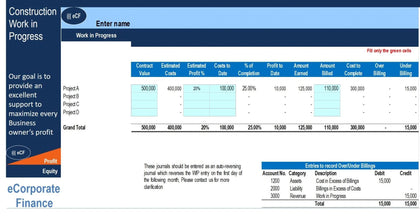Cash Conversion Cycle (CCC) Quarterly Tracker Template in Excel
The cash conversion cycle or CCC is really important to understand for any inventory manager or high level executive that deals in a company that primarily invests in inventory / materials and subsequently sells it. The main financial statement items that are needed in order to calculate this metric (reported as the number of days of the full cycle) include:
- Revenue
- Cost of Goods Sold (COGS)
- Starting/ending inventory balance
- Starting/ending payables value
- Starting/ending receivables value
Those data points should be measured in the period you are doing the CCC analysis on. So, if it is quarterly, then you want the 90-day revenue and corresponding COGS, and the value of starting/ending period receivable/payables in that 90-day time frame.
This template does a few things:
1. You will be able to play with a standalone model that just has a single period where data is entered and the resulting CCC length is displayed in days. Accompanying this model is a chart that should the actual by-day timeline of how long each stage of the cash conversion cycle takes. There was a bit of clever logic needed to get this visual working how I was hoping.
2. Provides a quarterly (or whatever period you want to report on) actual CCC analysis based on the actual data from your financial statement. The user can enter this for each period (for up to 20 periods) and the CCC length will show for each period dynamically. Many visualizations come with this tracker that shows a goal vs. actual metric as well as all key line item performance of the components that go into the calculation.
The goal is to make the CCC length as short as possible and it could even be negative if payables are not paid until after receivables have been collected. This means the cash flow is efficient. Usually this key metric is used in comparative analysis because it is not super useful on its own. You want to see how the figure does over time as well as compared to other similar companies.
Cash Conversion Cycle (CCC) Quarterly Tracker Template in Excel
Available:
In Stock
$45.00
The cash conversion cycle or CCC is really important to understand for any inventory manager or high level executive that deals in a company that primarily invests in inventory / materials and subsequently sells it. The main financial statement items that are needed in order to calculate this metric (reported as the number of days of the full cycle) include:
- Revenue
- Cost of Goods Sold (COGS)
- Starting/ending inventory balance
- Starting/ending payables value
- Starting/ending receivables value
Those data points should be measured in the period you are doing the CCC analysis on. So, if it is quarterly, then you want the 90-day revenue and corresponding COGS, and the value of starting/ending period receivable/payables in that 90-day time frame.
This template does a few things:
1. You will be able to play with a standalone model that just has a single period where data is entered and the resulting CCC length is displayed in days. Accompanying this model is a chart that should the actual by-day timeline of how long each stage of the cash conversion cycle takes. There was a bit of clever logic needed to get this visual working how I was hoping.
2. Provides a quarterly (or whatever period you want to report on) actual CCC analysis based on the actual data from your financial statement. The user can enter this for each period (for up to 20 periods) and the CCC length will show for each period dynamically. Many visualizations come with this tracker that shows a goal vs. actual metric as well as all key line item performance of the components that go into the calculation.
The goal is to make the CCC length as short as possible and it could even be negative if payables are not paid until after receivables have been collected. This means the cash flow is efficient. Usually this key metric is used in comparative analysis because it is not super useful on its own. You want to see how the figure does over time as well as compared to other similar companies.







































